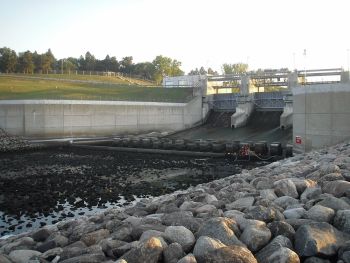Comprehensive Evaluation

|
| Outflows of Baldhill Dam, near Valley City, N.D., were cut so that inspectors could complete a periodic inspection of the structure.
(Image Source: Wikimedia) |
Comprehensive evaluation of dams is a vital process that involves assessing the safety, stability, and overall performance of dams. It evaluates various aspects of the dam, including structural integrity, hydraulic efficiency, environmental impact, and risk management.
The primary objectives of comprehensive evaluation of dams are to assess their structural integrity and efficiency. They also aim to identify any existing or potential issues, such as dam deterioration, seepage, or vulnerability to natural hazards. The potential environmental impact of the dam and its reservoir, including potential effects on water quality, wildlife habitats, and downstream ecosystems are also evaluated. As the dam is assessed, engineers consider the dam’s location and vulnerabilities to develop effective risk management strategies.
Comprehensive evaluation of dams involves a combination of visual inspections, structural analysis, hydraulic modeling, and geotechnical investigations. Visual inspections provide a first-hand assessment of the physical condition of the dam and its components. Structural analysis assesses the stability and structural integrity of the dam under distinct types of loading. Hydraulic modeling calculates the efficiency of spillways, outlet works, and other hydraulic structures by using varied, advanced modeling techniques. Geotechnical investigations assess the behavior and properties of the dam’s foundation and adjacent soils to ensure its long-term stability.
Comprehensive evaluation offers several benefits in dam management. Firstly, it ensures the safety of the dam by identifying any issues that may cause breaching or failure. This proactive detection enables timely repairs and reduces the risk of dam failures and incidents. Secondly, comprehensive evaluation increases the efficiency of the dam by identifying improvements that can enhance the dam's ability to provide reliable water supply, flood control, and hydropower generation. Moreover, the evaluation helps in environmental management by assessing the potential impacts of the dam on the surrounding ecosystems and guiding the implementation of mitigation measures.
The comprehensive evaluation of dams plays a crucial role in the risk management decision-making processes. By identifying vulnerabilities, such as inadequate spillway capacity or seepage concerns, appropriate solutions can be created and implemented. The evaluation informs engineers, enabling them to make appropriate decisions regarding dam rehabilitation and maintenance.
Comprehensive evaluation of dams is an integral part of long-term dam management practices. Regular assessments and periodic evaluations allow for the efficient management of dams. This proactive approach ensures the ongoing safety and performance of the dam, prolonging its lifespan, and minimizing the need for costly emergency repairs or rehabilitation. Furthermore, comprehensive evaluation ensures that dams meet regulatory standards and can perform their intended functions.
Best Practices Resources
![]() The Importance of Regular Dam Inspections
The Importance of Regular Dam Inspections
![]() Safety of Dams: Policy and Procedures (ER 1110-2-1156), USACE
Safety of Dams: Policy and Procedures (ER 1110-2-1156), USACE
